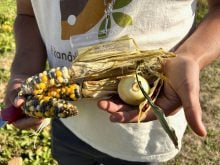The agriculture industry could never be accused of being stagnant when it comes to embracing new methods or technologies that enable more efficient food production.
It has also made huge strides in improving the sustainability of farming practices while increasing production of affordable food.
However, as industry leaders gathered at the GrowCanada conference in Calgary for the first time in two years earlier this month, they found their world has changed.
It wasn’t just the surreality of attending what was for many their first in-person event since the pandemic lockdowns began, or that it was taking place just as we are all coming to grips with yet another twist on that tiresome saga, or the fact that due to continuing consolidation, some of them are now working for yesterday’s competition.
Read Also

Still hard to predict precise fertilizer payback
Despite decades of advances, international research finds no clear answer for where and when adding nutrient will fail to boost growth.
They are facing new and potentially disruptive competition that looks nothing like them. New drivers such as climate change and animal welfare are attracting new capital from non-traditional investors, creating new technologies aimed at appeasing a growing consumer focus on sustainability and it is resulting in entirely new food categories and products.
More importantly, the focus of all that new investment is no longer on producing more for less. Lab-based meat and dairy produced from cells or fermentation, plant-based proteins, and concepts such as vertical farming are changing the value proposition to consumers and adding new layers to an already fragmented marketplace.
“The game is changing,” said Mary Shelman, the former director of Harvard Business School’s Agribusiness Program and an internationally recognized consultant on food system trends.
“Today there are vastly different visions of what a globally sustainable food system looks like,” she said. Those visions are often competing but they are collectively transforming the marketplace.
“It means who you will compete with and the basis of competition will fundamentally change,” she said.
Shelman sees four distinct pathways to sustainability. Many companies are starting to hedge their bets by investing in more than one.
Shelman cautioned that much of the agricultural industry represented at the GrowCanada conference is structured along the traditional path to sustainability, which pursues efficiency by driving costs out of the supply chain and “educating” consumers by telling them that food safety is supported by science and regulations.
“Just as an aside, consumers really don’t want to be ‘educated,’ they want to be engaged,” she noted.
The traditional approach has historically had trouble convincing farmers to buy in because new standards or regulations impose upfront costs on farmers with no correlation to how they are paid.
Shelman said for those systems to succeed in the future, they will have to get better at quantifying how they are sustainable through data and traceability.
“Historically, it’s been about producing cheap food and today we need to think about those chains as providing unique resources that fit into different sustainability dimensions,” she said.
As well, the new competitors are changing how different components or ingredients might be valued. “If you start unbundling certain dairy protein or certain cuts of meat, that disrupts the whole unit economics of the animal,” Shelman said.
Many companies are starting to differentiate their products using sustainability criteria, in which the supply chain effectively becomes the brand. This approach puts consumers in the driver’s seat and engages farmers through value-added propositions.
A third sustainability approach is focused on creating supply chains around plant-based foods and alternative proteins as a means of shifting consumption away from animal agriculture. It is drawing new investment and appeals to consumers convinced that animal industry is passé due to animal welfare concerns or environmental impact. But it remains to be seen whether these products can deliver on taste and environmental promises to rise above being niche players, she said.
Then there are the disrupters, new products such as ‘meats’ developed from cell-based or fermentation cultures, or vertical-farming operations that take farming out of the field and into controlled environments. The economics of those are still unproven but they are attracting significant investments, particularly in Asia.
For example, China has set a goal of reducing meat consumption by 50 per cent by 2030 as a means of achieving greenhouse gas emissions targets and reducing food security risks caused by animal disease. Singapore is investing in vertical farming as a way to achieve its goal of 30 per cent food self-sufficiency by 2030.
When asked for ideas for how the industry can better engage with consumers, she said it’s important to be transparent and provide measurable proof that an approach is sustainable. But it’s equally important that the sustainability target is actually addressing consumer concerns. Environmental and animal welfare have overtaken cheap food as a top-of-mind concern for many. “There are many others in the world who are concerned about the price of food, but those typically aren’t the voices that we hear so much,” she said.
Climate change and welfare concerns are even making many younger consumers more accepting of genetically engineered ingredients because they show a path away from animal agriculture.
Shelman noted one of the most successful examples of meeting consumers’ sustainability concerns is a National Audubon certification program in the U.S. focused on bird-friendly grasslands.
“There are now 1.5 million acres that have achieved the Audubon Society label,” she said. “In the U.S. there are 55 million professed bird lovers. So you can reach them on something that really matters to them, rather than compete on what sustainability really means.”
That’s a key take-away from Shelman’s talk. “There is basically almost a war going on. And it’s critical to prevent this war from turning into the same war that went on against GMOs,” she said. “To do this you have to recognize that you can’t keep doing business as usual, it’s no longer enough to just produce cheap food in throwaway packaging.”
There’s room for more than one approach in an increasingly fragmented marketplace. But all players need to accept that sustainability is non-negotiable. At the very least, they must improve how they source, how they communicate and how they measure.
















